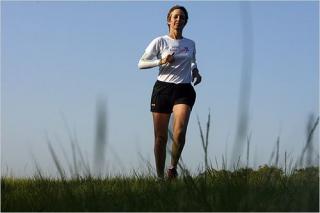iStride
Anh Ly
Lily Szajnberg
A device that helps runners correct their form by providing instant auditory feedback on their cadence and stride
http://itp.nyu.edu/~lrs372/lilysblog/?p=204

One of the most common mistakes that runners make when trying to increase their speed is over-striding, which shifts their center of gravity and actually reduces momentum and increases the chance of injury. Instead, a runner should strive to increase their cadence, which is the number of times a person's right or left foot hits the ground in one minute. Regardless of the pace, distance or height of a runner, the ideal cadence of any runner is 80-95 cycles per minute. Our device measures a person's cadence and beeps when the runner falls too far below the ideal range. A different, distinctive sound is emitted from the device as the runner approaches the 80-95 cadence range to indicate to him/her that they're near. This auditory response is a simple but effective way for people to improve their form and efficiency as they run.
*The visitor runs in place with the belt and tests whether they are reaching the optimal cadence.
Background
We researched various running magazines and sports science web sites on the relationship between running and cadence. What we found was that all elite runners ran at a cadence between 80-95 cycles per minute. An immediate feedback system allows the runner to feel out and adjust their cadence, which will ultimately help correct their form.
Audience
For amateur or elite runners and everyone in between
User Scenario
A belt will be strapped onto an audience member. The person will run in place, and a sound will indicate that they need to increase their cadence. No sound signifies that they are in the correct range.
Implementation
It's made of a lilypad arduino, an accelerometer and a belt.
Conclusion
We learned that a small addition and tweak to a former invention (the pedometer) can greatly improve usability and performance.
*The visitor runs in place with the belt and tests whether they are reaching the optimal cadence.
Background
We researched various running magazines and sports science web sites on the relationship between running and cadence. What we found was that all elite runners ran at a cadence between 80-95 cycles per minute. An immediate feedback system allows the runner to feel out and adjust their cadence, which will ultimately help correct their form.
Audience
For amateur or elite runners and everyone in between
User Scenario
A belt will be strapped onto an audience member. The person will run in place, and a sound will indicate that they need to increase their cadence. No sound signifies that they are in the correct range.
Implementation
It's made of a lilypad arduino, an accelerometer and a belt.
Conclusion
We learned that a small addition and tweak to a former invention (the pedometer) can greatly improve usability and performance.


